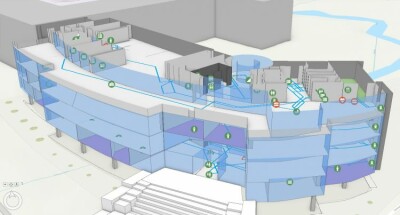While Esri is known for its GIS and geospatial tools, there is a growing need to track and map indoor environments. This mapping can be crucial to understanding existing site layouts, monitor assets, and serve as a foundation for navigation aids. Thanks to an Esri UK partnership announced earlier this year, the process of indoor space mapping has been put to the test at the University of Oxford.
The University of Oxford is known for being the oldest university in the English-speaking world, and is one of the world’s most prestigious centers of learning, teaching and research. More than 24,000 students attend the University, including 11,955 undergraduates and 12,010 postgraduates.
Consisting of a broad portfolio, the University of Oxford’s estate includes academic buildings, laboratories, student and staff accommodation, commercial buildings for investment and leasing purposes, farms, plus space embedded in a number of hospitals around Oxford. The university charges academic departments and colleges for the space they use and also leases buildings to commercial entities.
Working with Esri UK, the University of Oxford has now upgraded its entire estate management process with a new indoor map, providing better and more efficient methods to collect, andin maintain asset data. These data are used to assess how different university departments and tenants are charged for the space that they use, and to keep track of building maintenance and management tasks.
To create the new estate management processes, the University chose to utilize GIS mapping technology from Esri UK. The property, which consists of more than 300 buildings and 35,000 interior spaces, can be more easily accessed through the collected map than ever before.

Replacing static CAD floorplans, Excel spreadsheets and other paper records, the new solution combines over 2,000 existing CAD floorplans into a single interactive map, enabling the university to more easily visualize the campus. Interactive maps now give an overview of the estate, showing buildings in context of their surroundings down to individual floors, rooms and spaces, while interactive dashboards show floorplans, usage and cost details.

The map can also be shared online with building managers and department administrators. Within the new system is a two-way communications tool that allows for updates to maps and floorplans if they are changed. This has replaced the labor-intensive process of auditing the property for changes, and streamlines how the tenants are charged by the University.
“The challenge was to create an indoor mapping system which would provide 24hr access to floorplan and budget information for academic departments and other tenants and keep pace with the dynamic nature of our estate, which has several thousand changes every year, from repurposing an office into a laboratory to minor modifications such as moving internal walls,” explained Lomin Saayman, Information Records Manager, University of Oxford Estates Services.
“The Esri UK solution gives us a geographical visualization of our estate and allows tenants to report any changes so our central asset record is always up-to-date. The old process of confirming what space they occupied used to take around five months and wasted time chasing data, so now the estates team is free to work on other tasks. Overall, the increased visibility and accuracy is helping improve how we inform departments what they will be charged for the year and in how we plan for the future expansion of the estate. Purchasing the software via a Chest agreement also meant it was well within our budget,” concluded Saayman.
The new system is already contributing to the spatial planning of a large new laboratory facility being built, by revealing how the old 1960s building was previously used. Plans for the future include adding large or significant assets to the indoor mapping solution, such as an MRI scanner, by scanning items with a 3D scanner and making them visible on the map.
“Indoor mapping has made previously difficult to share static floorplan data rapidly accessible and easy to navigate by all stakeholders,” said Rob Nichols, Sales Lead at Esri UK.
“Bringing CAD data into a GIS mapping environment has given the university complete situational awareness of its whole estate, allowing it to improve operational efficiency and make accurate decisions.”








